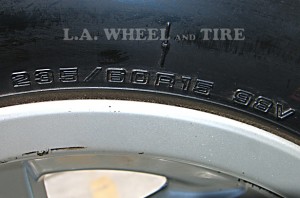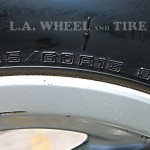
We don't always show off the "
and Tire" portion of our name,
L.A. Wheel and Tire, but it's a pretty important part of what we deal with every day. In a very real sense, all the wheels in the world couldn't do very much without tires (or maybe tracked treads, but that's neither here nor there).
Tire manufacturers are pretty smart people -- engineers, designers, and the like -- and they figured out that they could save a lot of people a lot of hassle by putting some information directly on the sidewall of every tire.
In
Tire Tech 101 -- the first of
our series on tires -- we'll give a tour of some of the most important bits of information that you can find on your tires, and what it all means.
Looking at these pictures, you see the following information:
[caption id="attachment_2160" align="aligncenter" width="300" caption="Tire Dimensions"]

[/caption]
P235/60R15 98V
P-Metric / Non-P-Metric Designation
If there's a "P" appended to the beginning of the information, this simply designates its a passenger car tire. If there's no "P" at the beginning, the tire is simply engineered to different standards. The standards are set by two organizations: the
T&RA (
The Tire and Rim Association) and the
ETRTO (
European Tyre and Rim Technical Organization).
Section Width
The next number ("235" in this case) measures the tire section width, in millimeters: the distance from sidewall to sidewall. Each tire is measured to specific rim width, and because rim width is often measured in inches here in the U.S., it's helpful to convert millimeters to inches. Divide the millimeters by 25.4 to get the measurement in inches.
Aspect Ratio
After the slash (/) is the aspect ratio (in this case, "60"), which compares the tire's section height -- the distance from bead to the tread -- to maximum section width. So, in this case, the 60 means that the tire's section height is 60% of the tire's section width.
Construction
A letter designation follows, indicating the type of ply construction in the tire's casing. "R" in this case stands for radial, while other designations are "D" for diagonal and "B" for belted. Don't mix construction types on a car; you'll regret it pretty fast!
Rim Diameter
This diameter is the rim diameter, usually in inches. Always match the tire's rim diameter to the wheel's rim diameter for safety and proper fit. In this case, the number is 15, so that should tell you that the wheels this will fit on are 15" wheels.
Service Description
This is actually an alphanumeric combination (in this example, "98V") that gives you both the load index and the speed rating. The
Load Index tells you the load carrying capacity of the tire, and is repeated on all U.S. tires with the load limit in pounds elsewhere on the tire. The
Speed Rating is the maximum speed that the tire is rated at the load specified by the load index. So, the example tires are rated at a "V" which means up to 149 mph (240 km). Speed ratings work like this:
Speed Rating / Test Speed
- Q / up to 100 mph (160 km)
- R / up to 106 mph (170 km)
- S / up to 112 mph (180 km)
- T / up to 118 mph (190 km)
- U / up to 124 mph (200 km)
- H / up to 130 mph (210 km)
- V / up to 149 mph (240 km)
- W / up to 168 mph (270 km)
- Y / up to 186 mph (300 km)
It's important to note that not all U.S. tires are speed rated, but most are.
ALWAYS replace tires with equal or higher rated tires, otherwise you could be looking at some dangerous changes to performance. Furthermore, regardless of what a tire says it's rated for, you should never break the speed limit, and you should never try to meet or exceed the listed speeds by rating. Performance and handling can all take a hit under various circumstances, and frankly, crashing your car is no good for anybody. Except maybe your insurance provider.
***
Was
Tire Tech 101: Dimensions useful?
Let us know in the comments below!
For more info:
 We don't always show off the "and Tire" portion of our name, L.A. Wheel and Tire, but it's a pretty important part of what we deal with every day. In a very real sense, all the wheels in the world couldn't do very much without tires (or maybe tracked treads, but that's neither here nor there).
Tire manufacturers are pretty smart people -- engineers, designers, and the like -- and they figured out that they could save a lot of people a lot of hassle by putting some information directly on the sidewall of every tire.
In Tire Tech 101 -- the first of our series on tires -- we'll give a tour of some of the most important bits of information that you can find on your tires, and what it all means.
Looking at these pictures, you see the following information:
[caption id="attachment_2160" align="aligncenter" width="300" caption="Tire Dimensions"]
We don't always show off the "and Tire" portion of our name, L.A. Wheel and Tire, but it's a pretty important part of what we deal with every day. In a very real sense, all the wheels in the world couldn't do very much without tires (or maybe tracked treads, but that's neither here nor there).
Tire manufacturers are pretty smart people -- engineers, designers, and the like -- and they figured out that they could save a lot of people a lot of hassle by putting some information directly on the sidewall of every tire.
In Tire Tech 101 -- the first of our series on tires -- we'll give a tour of some of the most important bits of information that you can find on your tires, and what it all means.
Looking at these pictures, you see the following information:
[caption id="attachment_2160" align="aligncenter" width="300" caption="Tire Dimensions"] [/caption]
[/caption]

